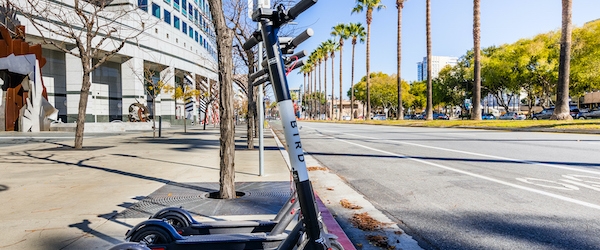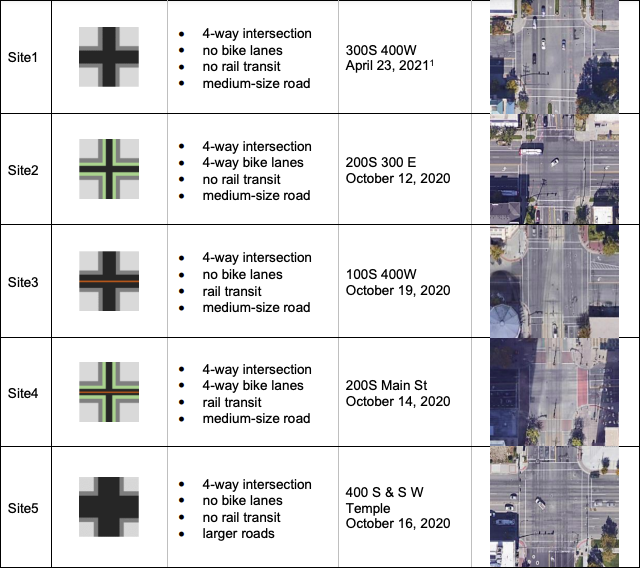Scooting to a New Era in Active Transportation: Examining the Use and Safety of E-Scooters

In recent years, shared electric scooters (e-scooters) have taken cities around the world by storm. But how are people using this new mode of transportation? Seeking to understand the potential impacts of e-scooters on land use, infrastructure and sustainability goals, researchers have some new interesting data to share on e-scooter users, exploring the interplay between demographics, behaviors and trip purposes.
Funded by the National Institute for Transportation and Communities (NITC) and led by Kristina Currans and Nicole Iroz-Elardo of the University of Arizona and Reid Ewing of the University of Utah, the study combines a user survey with on-the-ground observations to characterize the use and safety of e-scooters. The research team also included students Dong-ah Choi, Brandon Siracuse, and Torrey Lyons of the University of Utah and Quinton Fitzpatrick and Julian Griffee of the University of Arizona. The final report offers insights into what drives the behaviors of people using e-scooters, as well as those walking, biking and driving when e-scooters are present.
GATHERING DATA ON E-SCOOTER USERS
Along with a literature review and a review of existing agency regulations, the researchers analyzed results from an online survey, administered through the City of Tucson in the winter of 2019-2020 (prior to COVID-19 lockdowns later that spring). The online survey gathered information on stated preferences (e.g. whether people reported riding on the sidewalk, or at night) and whether e-scooters were substituted for other modes of transportation. Additionally, they looked for information on how crash experiences corresponded with demographics and riding behaviors.
Next came on-the-ground data collection. Researchers and students observed people riding e-scooters in Tucson in January of 2020; this data collection effort was soon curtailed by COVID-19 related lockdowns. In Salt Lake City, the team conducted observations in Fall 2020 and Spring 2021, once e-scooter trips began rebounding. They examined how transportation infrastructure— specifically bike lanes, the presence of light rail, and the size of the facility—relates to observations of non-optimal behaviors for different mode users (e-scooters, bicyclists, pedestrians, and drivers), and those behaviors for e-scooter users included:
- riding on sidewalks,
- riding in vehicle travel lanes,
- violating traffic signals,
- distracted riding,
- riding without a helmet,
- having two or more passengers on one scooter, or
- leaving a scooter parked improperly (for example blocking the sidewalk).
Researchers also recorded the behavior of cyclists, pedestrians and drivers. For more details on the observation protocols and the study sites, see chapter four of the final report.
HOW DOES INFRASTRUCTURE INFLUENCE TRAVEL BEHAVIOR?
For both e-scooters and bicycles, the type of infrastructure can affect how people ride. Based on observations, a few patterns emerged:
- When bike lanes were available, e-scooter riders generally used the sidewalks less.
- When light rail tracks were present, sidewalk riding happened at similar rates with and without bike lanes.
- On wider roads, e-scooter and bicycle users both significantly gravitated towards sidewalks.
Researchers chose their study sites in order to understand how infrastructure related to behavior for different mode users. They collected data at 5 different types of intersections in Salt Lake City:
The researchers presented a poster on this at TRB 2022: Effects of Intersection Design on Non-Optimal Behaviors of E-Scooter and Other Users. While the presence of multimodal infrastructure does matter, inadequate separation from larger automobile facilities may outweigh the use of "appropriate" facilities in the decision making process. This suggests that more optimal behaviors are likely to occur not where permitted, but where infrastructure provided is perceived to be safe.
Demographics also play a role: In terms of crash experiences, older respondents (40-60 years old) were much less likely to have experienced a crash compared with younger riders (<30 years of age).
OTHER E-SCOOTING BEHAVIORS
With the advent of a new form of transportation, there are many different behaviors to consider with regards to safety, how users might combine with other modes, and how to end their trips on these micromobility devices.
HELMETS
Helmets are legally required for e-scooter riders. Not surprisingly perhaps, the reported use of helmets in the survey (21% at least some of the time and 13% while riding) far outweighs the researchers' observations in Salt Lake City (2%) or Tucson (2%).
TRIP TYPES
A substantial portion of e-scooter riding in Tucson appears to be supporting more recreational travel. In fact, e-scooter trips appeared to generate new restaurant activities. This finding is commensurate with other research which indicates that active transportation travelers tend to spend more money at convenience stores, drinking establishments and restaurants. See two related NITC-funded studies: Examining Consumer Behavior and Travel Choices and Understanding Economic and Business Impacts of Street Improvements for Bicycle and Pedestrian Mobility.
E-scooter trips that were substituting for transit travel were more frequent for people with lower incomes or who were older than 30 years of age, but especially for those older than 60 years of age.
PARKING
Of the 292 total parked e-scooters observed in Tucson, 76% of all e-scooters were well parked. 17% were improperly parked, and approximately 7% were questionably parked (meaning either there was ambiguity about the rules or a lack of context in the photo). Each vendor has their own mechanisms to educate chargers and riders about properly parking scooters; it is likely that parking might vary by vendor. Parking may also vary greatly in neighborhoods without designated parking zones.
IMPLICATIONS FOR POLICY AND PRACTICE
The findings from this study can be used to inform policy and practice in a myriad of ways. The safety and infrastructure-related findings can help decision-makers to prioritize and revise regulations and requirements for new micro-mobility options in mid-sized cities. The information on usage behavior can help practitioners advance the integration of new technologies into transportation systems to improve overall safety and performance. Finally, the insights with regard to modal substitution may provide evidence to support considering micro-mobility options as a feasible strategy for reducing the greenhouse gas emissions of short-trip travel.
Join the research team on June 7, 2022 to hear first-hand the results of their research at an upcoming free online webinar hosted by NITC.
ABOUT THE PROJECT
- Download the Final Report (PDF)
- Download the Project Brief (PDF)
- Register for the June 7 Webinar which will cover findings from this project, along with two other NITC projects on e-scooters coming out soon:
This research was funded by the National Institute for Transportation and Communities, with additional support from the Arizona Board of Regents, the City of Tucson, Salt Lake City Corporation, the University of Arizona and the University of Utah.
Photo by Sundry Photography/iStock
RELATED RESEARCH
To learn more about this and other NITC research, sign up for our monthly research newsletter.
- New Mobility For All: Can Targeted Information And Incentives Help Underserved Communities Realize The Potential Of Emerging Mobility Options?
- Mobility for the People: Evaluating Equity Requirements in Shared Mobility Programs
- Evaluation of Portland Shared E-Scooter Pilot Program Goals and Outcomes
The National Institute for Transportation and Communities (NITC) is one of seven U.S. Department of Transportation national university transportation centers. NITC is a program of the Transportation Research and Education Center (TREC) at Portland State University. This PSU-led research partnership also includes the Oregon Institute of Technology, University of Arizona, University of Oregon, University of Texas at Arlington and University of Utah. We pursue our theme — improving mobility of people and goods to build strong communities — through research, education and technology transfer.

